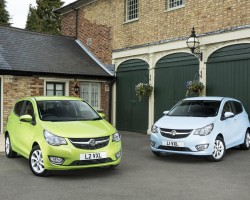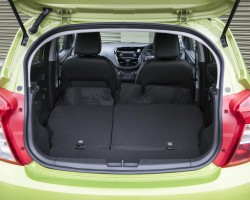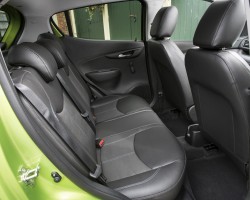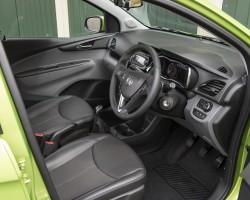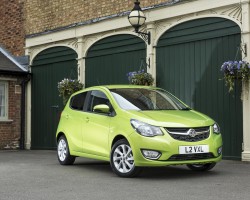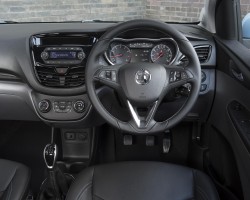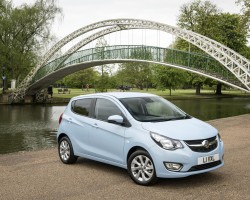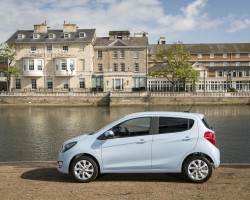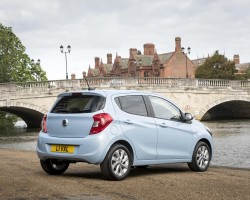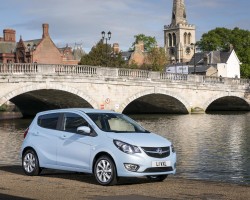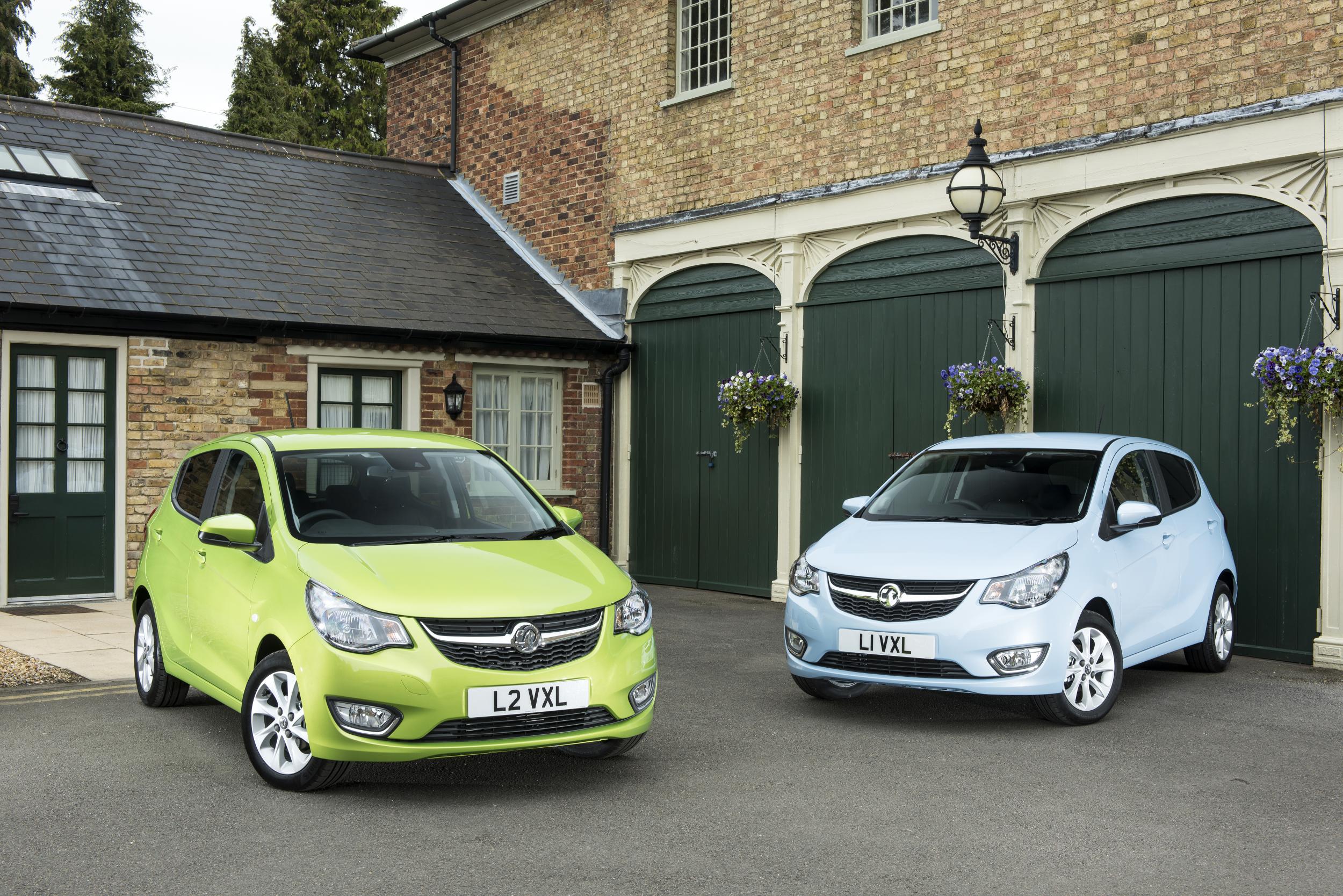
MARKET AND MODEL
- Vauxhall launches new VIVA after Geneva preview
- Familiar name, cheeky looks and generous equipment
- Arrives in showrooms next month priced from £7,995 OTR
DESIGN
- Designed for modern, everyday life with room for up to five people
- Latest model to display Vauxhall’s sculptured, precise design philosophy
- Shares the original’s clean lines, practicality and durability
POWERTRAIN & CHASSIS
- New 1.0-litre three-cylinder ECOTEC engine
- Achieves 65.7mpg combined and 99g/km CO2
- UK-developed chassis with benchmark comfort and safety
CONNECTIVITY
- IntelliLink available on all models from early 2016
- Vauxhall OnStar also available January 2016
PRICING, RANGE & EQUIPMENT
- Range priced from £7,995 to £9,495
- Two trim levels: SE and SL
- Exceptional levels of standard spec
VIVA HERITAGE
- Viva HA
- Viva HB
- Viva HC
MARKET AND MODEL
- Vauxhall launches new VIVA after Geneva preview
- Familiar name, cheeky looks and generous equipment
- Arrives in showrooms next month priced from £7,995 OTR
With a familiar name, cheeky looks, generous equipment and a level of quality that confounds at a sub-£8k entry price, the new Vauxhall VIVA arrives in showrooms next month, just four months after its Geneva Show debut.
VIVA joins Vauxhall’s growing small-car family, which already includes ADAM and Corsa, but is clearly defined from these models by its value, functionality, range and dimensions.
VIVA will appeal to customers looking for value for money, but who are not prepared to compromise on quality. And unlike many of its rivals, VIVA can accommodate up to five people and has the convenience of five doors.
With a 90:10 retail/fleet split, sales are predicted to be heavily weighted towards private buyers. With this in mind, VIVA will be available on highly-competitive personal contract purchase (PCP) plans for retail customers.
Competing in the A-segment, VIVA’s rivals include the Hyundai i10, Volkswagen Up, Toyota Aygo, Peugeot 108 and Citroen C1.
“Short, crisp and full of character, Vauxhall’s new entry-level model is a proper small car and will hold great appeal in this rapidly growing sector,” said Tim Tozer, Vauxhall’s Chairman and Managing Director.
DESIGN
- Designed for modern, everyday life with room for up to five people
- Latest model to display Vauxhall’s sculptured, precise design philosophy
- Shares the original’s clean lines, practicality and durability
With a name that pays homage to Vauxhall’s original Viva made from 1963 to 1979, the all-new VIVA shares the original’s philosophy of clean lines, durability and practicality. It is designed for modern, everyday life and at 3.68 metres long is practical and spacious providing more than enough room for up to five people.
VIVA is the latest model in the range to display Vauxhall’s sculptured, precise design philosophy. Three strong feature lines swoop down the sides with the signature ‘blade’, seen previously on Insignia and GTC amongst others, slicing through the doors. The two others run through the front and rear door handles. The VIVA’s front end features a distinctive winged chrome bar that presents the Griffin badge.
Large headlights and taillights add to the vibrant appearance, creating an overall design that shows exceptional attention to detail for a vehicle in this class.
VIVA is available in ten exterior paint colours with a variety of 15- to 16-inch wheels.
POWERTRAIN & CHASSIS
- New 1.0-litre three-cylinder ECOTEC engine
- Achieves 65.7mpg combined and 99g/km CO2
- UK-developed chassis with benchmark comfort and safety
After first appearing in the ADAM ROCKS AIR and subsequently the New Corsa and ADAM, VIVA is the latest Vauxhall to feature the new 1.0-litre three-cylinder ECOTEC engine.
Specially-developed for VIVA and achieving up to 65.7mpg combined with CO2 emissions as low as 99g/km, this 75PS powertrain is smooth, punchy and efficient, and is mated to a slick five-speed transmission.
The three-cylinder engine is made from light aluminium and has better running characteristics and noise emission than some four-cylinder units. Annoying vibrations that can be the trademark of some three-cylinder engines have been eliminated thanks to a number of measures:
- Ground-up block design with key focus on resonance reduction
- Integration of exhaust manifold into the cylinder head to further reduce noise
- Sound-absorbing cam-cover
- Timing chain ‘trimmed’ to reduce clatter (backward-leaning teeth in chain are friction-optimised and grip the spur wheels of the crank and camshaft)
The 1.0-litre ECOTEC has four valves per cylinder, controlled by two overhead camshafts. The camshaft control is variable for the intake and exhaust sides, and combined with port injection ensures optimised gas exchange throughout the entire rpm range. This adds to both driving pleasure and efficiency.
A three-cylinder engine is an inherently efficient unit, with internal friction considerably lower than in a comparable four-cylinder unit. To make the engine as light as possible, the crankshaft is hollow cast, the oil pump drive is especially low friction and the oil pump works at two pressure levels – a special feature in this class.
The entire engine is designed for low friction oils with a viscosity grade of 5W-20. All of these measure ensure excellent fuel efficiency.
“Our three-cylinder engine in VIVA is the latest addition to a new generation of engines which were developed with the focus on outstanding efficiency, smooth running characteristics and low noise emission,” said Charles J. Klein, Vauxhall/Opel’s Vice President Vehicle Engineering, Europe.
Powertrain Offensive
The one-litre engine in VIVA is part of Vauxhall/Opel’s large-scale engine offensive, which started last year and will bring 17 new ultra-modern powertrains to market before 2018. The 1.0-litre ECOTEC (75PS) is the base engine of a new generation of small Vauxhall petrol engines. The next more powerful version is the 1.0 ECOTEC Direct Injection Turbo that has been available in ADAM and Corsa since last year with an output of either 90PS or 115PS. Later this year, a 105PS version will appear in the all-new Astra.
Chassis
VIVA’s chassis and steering have been developed and benchmarked with rivals on UK roads to provide exceptional safety and class-leading comfort.
The front suspension has side-load compensation springs that improve the ride performance and damper reliability. Double bonded bushings also increase ride and handling performance while simultaneously minimising noise, vibration and harshness (NVH), with their high structural stiffness supporting superior handling performance.
Additional ride-improving measures have also been implemented for the rear suspension. The V-section tubular-type torsion beam is mounted in front of the rear wheels allowing the roll-rate and roll-steer characteristics to be perfectly aligned with engine power and vehicle weight. Furthermore, rear dampers are vertically mounted behind the rear wheels to provide a good shock leverage ratio and efficient damping performance, and the vertical dual-path mount provides better ride and NVH performance.
CONNECTIVITY
- IntelliLink available on all models from early 2016
- Vauxhall OnStar also available January 2016
Like its stablemates ADAM and Corsa, VIVA will be fully connected thanks to the next generation IntelliLink infotainment system. Available from early 2016, IntelliLink allows seamless integration of Apple iOS and Android devices, including full compatibility with Apple CarPlay and Android Auto.
OnStar
Also available from January 2016, as standard on SL trim and as an option on SE, will be the personal connectivity and service assistant OnStar. OnStar is already the leading provider of connected safety and security solutions, value-added mobility services and advanced information technology in North America, China and Mexico.
Customers will be able to use a broad portfolio of services provided by Vauxhall OnStar such as emergency services, roadside recovery and smartphone remote control. In addition, when equipped with OnStar, VIVA will become a Wi-Fi hotspot, enabling up to seven devices to be connected to the car network.
OnStar is also there in case of an emergency – whether you can ask for it yourself or not. For example, if an airbag deploys, OnStar will be alerted automatically. An advisor will then contact the subscriber to determine whether help is required. If there is no response, emergency responders will immediately be sent to the exact location of the vehicle.
OnStar Advisors located at the high-tech OnStar Contact Centre in Luton, England, will be available 24/7 and 365 days a year. At a push of the SOS button, OnStar users can request assistance whenever they deem it necessary, for example if they witness an accident.
Via the Smartphone App, subscribers will be able to call OnStar from anywhere, access important vehicle data such as oil life and tyre pressure, remotely lock or unlock the car and (if their car has been stolen) locate it with Stolen Vehicle Assistance which can also remotely block the ignition.
PRICING, RANGE & EQUIPMENT
- Range priced from £7,995 to £9,495
- Two trim levels: SE and SL
- Exceptional levels of standard spec
Vauxhall’s all-new five-door VIVA will arrive in showrooms in June priced from £7,995 on-the-road.
The VIVA range consists of two trim levels: SE and SL, which is a trim name carried over from the original Vauxhall Viva. There will be Air Con and ecoFLEX versions of the SE trim, giving customers a choice of four well-specified models (SE, SE Air Con, SE ecoFLEX and SL).
Both VIVA trim levels feature a high level of standard equipment. Tyre pressure monitoring system, city mode steering, lane departure warning, cruise control with speed limiter and front fog lights with cornering function are standard.
Class-leading technology including ESP which features traction control, cornering brake control, emergency brake assist, straight line stability control and hill start assist are also standard across the range. All VIVA models feature six airbags, AM/FM radio with aux-in and steering wheel controls, electric front windows, electric/heated mirrors and remote central door locking.
Achieving 65.7mpg combined and 99g/km, the VIVA SE ecoFLEX gets a front lip spoiler, extended rear spoiler and ultra-low rolling resistance tyres over the entry model. It is priced from £8,170 on-the-road.
Priced from £9,495 on-the-road, SL trim features electronic climate control, Morocanna seat trim, leather steering wheel and 15-inch alloy wheels. Other highlights include six speakers, USB audio connection, Bluetooth music streaming and mobile phone portal.
Options available include Winter Pack (heated seats and steering wheel), rear parking sensors and electric glass sliding sunroof.
Full VIVA pricing is as follows:
| Model | On-the-road | CO2 | Fuel Economy |
| 5-door | (£) | (g/km) | (mpg) |
| SE | |||
| 1.0i 75PS | 7,995.00 | 104 | 62.8 |
| 1.0i 75PS ecoFLEX | 8,170.00 | 99 | 65.7 |
| 1.0 75PS (a/c) | 8,490.00 | 104 | 62.8 |
| SL | |||
| 1.0i 75PS | 9,495.00 | 104 | 62.8 |
Full specification is as follows:
SE
Safety
Anti-lock Braking System (ABS)
Electronic Stability Programme (ESP) with traction control
Driver’s and front passenger’s airbags
Front seat side-impact airbags
Curtain airbags
Tyre pressure monitoring system
Lane departure warning
ISOFIX child seat restraint system for outer rear seats
Three inertia-reel lap and diagonal rear seatbelts
Perimeter alarm system
Electronic engine deadlock immobiliser
Speed-sensitive power-assisted steering with City Mode
Electrically operated front windows
Electrically adjustable/heated door mirrors
Cruise control with speed limiter
Multi-function trip computer
Stereo radio with aux-in
Steering wheel mounted audio controls
Tiltable steering column
Driver’s seat height adjuster
Height-adjustable front seat head restraints
60/40 split-folding rear seat back and seat base
Removable luggage compartment cover
Exterior features
Daytime running lights
Front fog lights with cornering function
Emergency tyre inflation kit
15-inch structure wheels
SE ecoFLEX model:
Front lip spoiler
Extended rear spoiler
Ultra-low rolling resistance tyres
SL
Features over SE:
Electronic climate control
USB audio connection
Bluetooth music streaming
Bluetooth mobile phone portal
Six speakers
Two-tone grey facia
Leather-covered steering wheel
Dark-tinted rear windows
15-inch alloy wheels
VIVA HERITAGE
- Viva HA
- Viva HB
- Viva HC
Viva HA
While Vauxhall’s first foray into the compact family car market came in 1936 with the H-Type – the world’s first unitary construction (monocoque) model, it was the launch of the Viva in 1963 that really saw the Griffin gain momentum. Launched in 1963, the Viva was initially built in Luton, with production transferring to the brand new Ellesmere Port facility the following year – home to each generation of compact Vauxhall family car ever since. Light, simple to maintain and neatly styled the HA Viva was just the ticket for motorists who wanted a no-nonsense, inexpensive family car and its ease-of-maintenance gave it particular appeal in the days when part of Dad’s weekly routine was to spend an hour tinkering on a Sunday! Over 300,000 Viva HAs were sold in a relatively short lifespan of just three years, although the Bedford Van variant – the HAV – continued well into the 1980s thanks to its fleet appeal.
Viva HB
Whereas the Viva HA’s appeal lay very much in its simplicity, its successor moved Vauxhall’s compact car offering up towards a far more mature and discerning audience. Gone were the original car’s simple transverse leaf suspension and narrow track, replaced by a car that used sophisticated coil springs all round. The styling was also much more modern – the famous ‘coke bottle’ swage line seen in many cars of the era made its debut on the HB Viva, giving it a look that still appears relatively fresh today. It was also offered in more body styles than ever before – two and four-door saloons, as well as a stylish estate. Performance versions included the ‘Brabham’ Viva, developed for GM by the 1966 F1 champion Jack Brabham and sold through his own dealership, and the even more potent Viva GT with trademark matt black bonnet and the ability to crack 100mph, making it a firm favourite among the motorsport fraternity. Over half a million Viva HBs were sold in four years.
Viva HC
The longest production run of any Viva model was enjoyed by the HC, which remained a stalwart of the Vauxhall range from its introduction in 1970 through till the end of 1979. So advanced was the HB Viva’s four-link rear and independent front suspension set-up that it was carried over directly to the HC, along with much of the car’s structural and mechanical architecture. Where the HC differed was in its styling, substituting the curvy HB look with more angular, straight lines. Many styling cues were taken from Detroit, with the car’s fluted bonnet resembling that of a contemporary Pontiac, rear lamp units reminiscent of a Buick Regal and unusual ‘wave’ effect wheelarches, which gave the car a forward-leaning appearance. The HC also reflected the rapidly growing fleet market in the UK, with a much broader range of engines and trim levels than ever before. The two-door and four-door saloons were complemented by an unusual looking estate, as well as the Firenza – a two-door coupe that squared up to Ford’s Capri in this style conscious sector of the market. In 1973, the Magnum appeared, effectively a renamed version of the larger-engined HC Vivas aimed at more upmarket audience – the car was pitched as much more of a rival to the Triumph Dolomite than it was to the Morris Marina, for example. Perhaps the most iconic versions of the HC, despite their minuscule volumes, were the ‘Droop Snoot’ Firenza and Sporthatch models, finished in Silver Starfire metallic paint and fitted with unusual polyurethane ‘beak’ containing triple headlights. They are by far the most collectable HC variants today.

